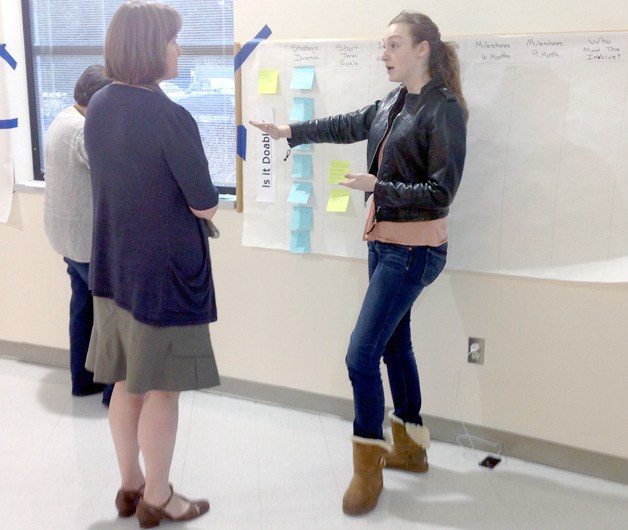Shaping the future of South Whidbey’s schools began with a marathon meeting last Saturday.
The potentially short-lived, long-range planning committee convened to discuss the coming years for the South Whidbey School District. Two dozen members pitched in on five areas: improved accountability and support, increased community partnerships, effective use of resources, district-wide focus and program and curriculum management.
“This is a long-range plan, so we feel like we need to take a real good look at everything we can, (including) what’s been done in the past,” said Steve Scoles, a committee member and chairman of the school board.
When there are 24 people crafting what classes will be where and for how long, a six-hour meeting seemed insufficient to produce action plans for the school board.
And it was.
The committee has two more meetings planned this month to hone its action plans. All of the discussions and work will result in a recommendation to the school board, possibly in April, about how the district could look during the next decade.
“I’m hoping the committee will come up with some pretty clear recommendations,” Scoles said.
One of the most contested issues is facility use, encompassed in the resources portion of the committee’s agenda. Consolidation of Langley Middle School and South Whidbey High School was reneged on by the school board in December 2011 after a voter uprising. A pair of board members were elected, unopposed, as clear supporters of keeping the middle school open.
Since then, the school board and Superintendent Jo Moccia attempted to change the public conversation. Rather than focus on closing Langley Middle School or consolidating the sixth, seventh and eighth-grade students elsewhere, district leaders framed the discussion as a program concern.
Avoiding gaps in students math instruction, for example, was a key concern for the program and curriculum management group. That grew into the need for students to recognize the real-world use of their skills.
“We want kids to be able to take what they’re learning and apply it,” Moccia said.
Before any decision could be made, principals and teachers created the district’s program matrix, a complete list of the classes, activities, sports and clubs offered by South Whidbey schools.
With the matrix in mind, the long-range planning committee will attempt to configure about 1,400 students into three main campuses (a fourth exists at the primary campus, where the K-12 alternative program South Whidbey Academy operates).
Unused space has Scoles and other committee members aware that further enrollment decline could result in some kind of consolidation. In the 2006-07 school year, almost 1,900 students were enrolled in the South Whidbey School District. Now there are about 1,420. About 500 students are enrolled at the high school, 335 at the middle school, 520 at the elementary school and 68 in the academy.
The district’s concern is the decline in cohort numbers. Where the high school’s ranks have between 107 and 145 students from ninth to 12th grade, the elementary school’s cohorts are smaller with between 92 and 103 students in first through fifth grades.
“If we continue shrinking, we’re going to have to downsize and consolidate in some way,” Scoles said.
Even if the district avoids shuttering a building some day, its teaching and service offerings would shrink. That’s when community partnerships could fill in the gap.
Electives like art and music are usually the first to be trimmed because school districts must offer basic education for state standards. Langley Middle School, for example, is surrounded by Island Dance Theater, Whidbey Island Center for the Arts and Creativity Source, a film production company. All three buildings are on school district property, and the dance and production companies occupy school district buildings.
“I get all excited when we start talking about community partnerships, a lot of people get excited about community partnerships,” said Margot Jerome, the committee facilitator. “The level of intelligence in this area is staggering in a good way.”
Discussion of how bringing in nonprofits or businesses to educate students in the arts or other subjects could undermine or undervalue professional, certified educators briefly occurred. But it was not a major deterrent to the idea of bringing in outside groups to teach.
Moccia selected the 24 committee members among almost 40 applicants. Two members are high school students, two are currently employed South Whidbey School District teachers, one is a staff member and Assistant Superintendent Dan Poolman is also part of the committee.
The meeting featured a “reverse fishbowl.” Observers, about a dozen of whom attended the meeting, gave the committee suggestions and critique about what they saw and heard during the six-hour day.



